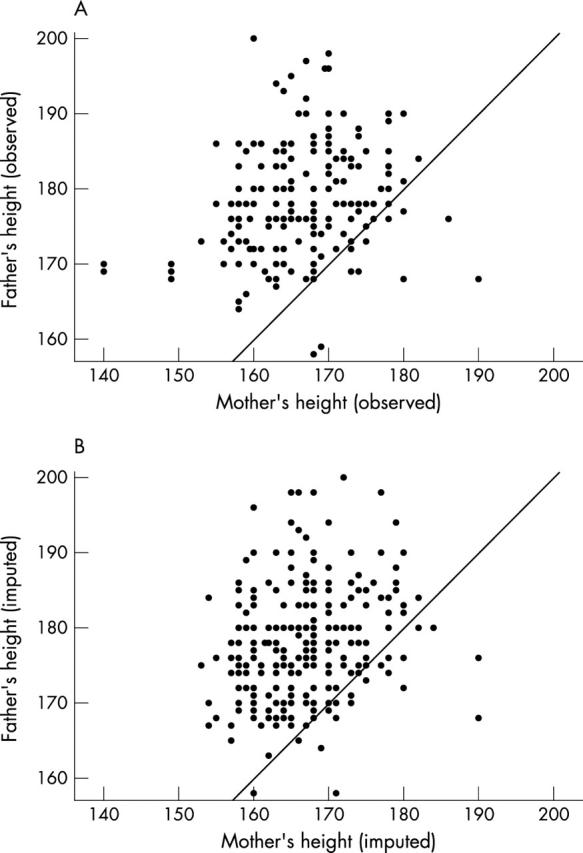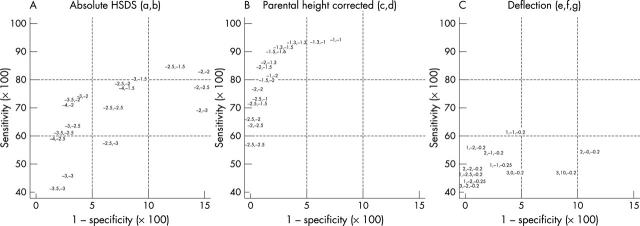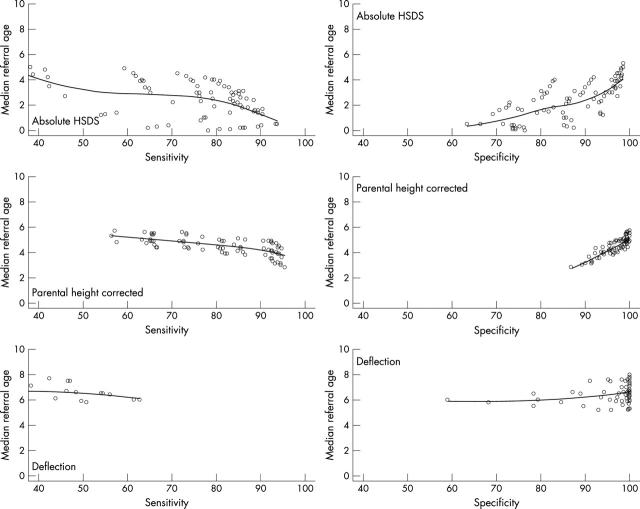Abstract
Aims: To evaluate the performance of growth monitoring in detecting diseases. Turner's syndrome (TS) is taken as the target disease.
Methods: Case-control simulation study. Three archetypal screening rules are applied to longitudinal growth data comparing a group with TS versus a reference group from birth to the age of 10 years. Main outcome measures were sensitivity, specificity, and median referral age.
Results: Clear differences in performance of the rules were found. The best rule takes parental height into account. Combining rules could improve diagnostic accuracy.
Conclusion: Growth monitoring is useful to screen for TS. A combined rule that takes absolute height SDS, parental height, and deflection in height velocity into account is the best way to do this. Similar research is needed for other diseases, populations, and ages, and the results should be synthesised into evidence based referral criteria.
Full Text
The Full Text of this article is available as a PDF (441.0 KB).
Figure 1 .

Father's height plotted against mother's height in the reference sample. (A) Observed data from group in which both parental heights are known (n = 203). (B) Imputed (artificial) data for cases where at least one parental height is missing (n = 286). The reference line indicates the location of equal parental heights.
Figure 2 .
ROC plot of different scenarios under three archetypal rules. Each scenario is labeled by its parameter values according to table 1. For example, the label "(-3, -2)" in the left plot indicates the scenario with a = -3 and b = -2. Only scenarios with p = q = r = 3 (cf table 1) are plotted.
Figure 3 .
Median referral age of girls with TS as a function of sensitivity and specificity under each rule. Every dot corresponds to a scenario.
Selected References
These references are in PubMed. This may not be the complete list of references from this article.
- Fredriks A. M., van Buuren S., Burgmeijer R. J., Meulmeester J. F., Beuker R. J., Brugman E., Roede M. J., Verloove-Vanhorick S. P., Wit J. M. Continuing positive secular growth change in The Netherlands 1955-1997. Pediatr Res. 2000 Mar;47(3):316–323. doi: 10.1203/00006450-200003000-00006. [DOI] [PubMed] [Google Scholar]
- Garner P., Panpanich R., Logan S. Is routine growth monitoring effective? A systematic review of trials. Arch Dis Child. 2000 Mar;82(3):197–201. doi: 10.1136/adc.82.3.197. [DOI] [PMC free article] [PubMed] [Google Scholar]
- Gicquel C., Gaston V., Cabrol S., Le Bouc Y. Assessment of Turner's syndrome by molecular analysis of the X chromosome in growth-retarded girls. J Clin Endocrinol Metab. 1998 May;83(5):1472–1476. doi: 10.1210/jcem.83.5.4805. [DOI] [PubMed] [Google Scholar]
- Hall D. M. Growth monitoring. Arch Dis Child. 2000 Jan;82(1):10–15. doi: 10.1136/adc.82.1.10. [DOI] [PMC free article] [PubMed] [Google Scholar]
- Hindmarsh P. C. Monitoring children's growth. Abnormal growth should also be defined by the crossing of height centiles. BMJ. 1996 Jan 13;312(7023):122–122. doi: 10.1136/bmj.312.7023.122a. [DOI] [PMC free article] [PubMed] [Google Scholar]
- Macaskill Petra, Walter Stephen D., Irwig Les, Franco Eduardo L. Assessing the gain in diagnostic performance when combining two diagnostic tests. Stat Med. 2002 Sep 15;21(17):2527–2546. doi: 10.1002/sim.1227. [DOI] [PubMed] [Google Scholar]
- Massa G. G., Vanderschueren-Lodeweyckx M. Age and height at diagnosis in Turner syndrome: influence of parental height. Pediatrics. 1991 Dec;88(6):1148–1152. [PubMed] [Google Scholar]
- Mulligan J., Voss L. D., McCaughey E. S., Bailey B. J., Betts P. R. Growth monitoring: testing the new guidelines. Arch Dis Child. 1998 Oct;79(4):318–322. doi: 10.1136/adc.79.4.318. [DOI] [PMC free article] [PubMed] [Google Scholar]
- Reiter E. O., Blethen S. L., Baptista J., Price L. Early initiation of growth hormone treatment allows age-appropriate estrogen use in Turner's syndrome. J Clin Endocrinol Metab. 2001 May;86(5):1936–1941. doi: 10.1210/jcem.86.5.7466. [DOI] [PubMed] [Google Scholar]
- Rongen-Westerlaken C., Corel L., van den Broeck J., Massa G., Karlberg J., Albertsson-Wikland K., Naeraa R. W., Wit J. M. Reference values for height, height velocity and weight in Turner's syndrome. Swedish Study Group for GH treatment. Acta Paediatr. 1997 Sep;86(9):937–942. doi: 10.1111/j.1651-2227.1997.tb15174.x. [DOI] [PubMed] [Google Scholar]
- Sas T. C., de Muinck Keizer-Schrama S. M., Stijnen T., Jansen M., Otten B. J., Hoorweg-Nijman J. J., Vulsma T., Massa G. G., Rouwe C. W., Reeser H. M. Normalization of height in girls with Turner syndrome after long-term growth hormone treatment: results of a randomized dose-response trial. J Clin Endocrinol Metab. 1999 Dec;84(12):4607–4612. doi: 10.1210/jcem.84.12.6241. [DOI] [PubMed] [Google Scholar]
- Sävendahl L., Davenport M. L. Delayed diagnoses of Turner's syndrome: proposed guidelines for change. J Pediatr. 2000 Oct;137(4):455–459. doi: 10.1067/mpd.2000.107390. [DOI] [PubMed] [Google Scholar]
- Van Buuren S., Fredriks A. M., Verkerk P. H. Consensus 'Diagnostiek kleine lichaamslengte bij kinderen'. Ned Tijdschr Geneeskd. 1999 Jul 24;143(30):1585–1586. [PubMed] [Google Scholar]
- Van den Broeck J., Hokken-Koelega A., Wit J. Validity of height velocity as a diagnostic criterion for idiopathic growth hormone deficiency and Turner syndrome. Horm Res. 1999;51(2):68–73. doi: 10.1159/000023317. [DOI] [PubMed] [Google Scholar]
- Voss L. D. Changing practice in growth monitoring. BMJ. 1999 Feb 6;318(7180):344–345. doi: 10.1136/bmj.318.7180.344. [DOI] [PMC free article] [PubMed] [Google Scholar]
- de Muinck Keizer-Schrama S. M. Consensus 'diagnostiek kleine lichaamslengte bij kinderen'. Ned Tijdschr Geneeskd. 1998 Nov 14;142(46):2519–2525. [PubMed] [Google Scholar]
- van Buuren S., Boshuizen H. C., Knook D. L. Multiple imputation of missing blood pressure covariates in survival analysis. Stat Med. 1999 Mar 30;18(6):681–694. doi: 10.1002/(sici)1097-0258(19990330)18:6<681::aid-sim71>3.0.co;2-r. [DOI] [PubMed] [Google Scholar]




